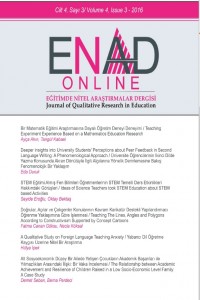Deeper insights into University Students' Perceptions about Peer Feedback in Second Language Writing: A Phenomenological Approach
Öz
This phenomenological study was carried out to analyze whether students attending to a preparatory programme in a Turkish state university changed their perceptions about peer feedback after training them. The study was conducted with 25 students from the department of Medicine all of whom were attending the Mandatory English Preparatory Program in 2014 academic year. In this qualitative study, the research data were obtained from students via semi-structured interviews which were applied at the beginning and at the end of the study to have clear insights about students’ perceptions on peer feedback before/after training them. During each training process, students were asked to write reflections after each feedback session, and each of them was analyzed to design the next training session. The data collected in the study were analyzed by content analysis technique and all the data were analyzed manually. The study findings revealed that training students on peer feedback yielded different results about their perceptions on peer feedback.
Anahtar Kelimeler
Kaynakça
- Baker, M., McQuade, D., Sommers, N., & Tratner, M. (1989). Resources for Teaching Student Writers at Work and in the Company of Other Writers: The Bedford Prizes (pp. 102-107). New York: St. Martin’s Press.
- Benesch, S. (1984). Improving peer response: collaboration between teachers and students. Urbana, IL. ERIC Document Reproduction Service.
- Berg, B. C. (1999). The effects of trained peer response on ESL students’ revision types and writing quality. Journal of Second Language Writing, 8(3), 215–241.
- Braine, G. (2003). From a teacher-centered to a student-centered approach: A study of peer feedback in Hong Kong writing classes. Journal of Asian Pacific Communication, 13, 269–288.
- Connor, U., & Asenavage, K. (1994). Peer response groups in ESL writing classes: How much impact on revision? Journal of Second Language Writing, 3(3), 257–276.
- Creswell, J.W. (1994). Research design: qualitative, quantitative and mixed approaches. NY: Sage.
- Hansen, J., & Liu, J. (2005). Guiding principles for effective peer response. ELT Journal, 59, 31–38.
- Hu, G. (2005). Using peer review with Chinese ESL student writers. Language Teaching Research, 9(3), 321–342.
- Huff, R., & Kline, C. R. (1987). The Contemporary Writing Curriculum: Rehearsing, Composing, and Valuing. New York: Teachers College Press.
- Jacobs, G. M., Curtis, A., Braine, G., & Huang, S.-Y. (1998). Feedback on student writing: Taking the middle path. Journal of Second Language Writing, 7(3), 307–317.
- Min, H. T. (2005). Training students to become successful peer reviewers. System, 33(2), 293–308.
- Min, H. T. (2006). The effects of trained peer review on EFL students’ revision types and writing quality. Journal of Second Language Writing, 15, 118–141.
- Nystrand, M. (1989). A social-interactive model of writing. Written Communication 6, 66-85.
- Paulus, T. M. (1999). The effect of peer and teacher feedback on student writing. Journal of Second Language Writing, 8, 265–289.
- Rollinson, P. (2005). Using peer feedback in the ESL writing class. ELT Journal, 59, 23–30.
- Stanley, J. (1992). Coaching student writers to be effective peer evaluators. Journal of Second Language Writing, 1, 217– 233.
- Topping, K. J. (2000). Peer Assisted Learning: A Practical Guide for Teachers. Cambridge, MA: Brookline Books.
- Tsui, A. B. M., & Ng, M. (2000). Do secondary L2 writers benefit from peer comments? Journal of Second Language Writing, 9(2), 147–170.
- Zhang, S. (1995). Reexamining the affective advantage of peer feedback in the ESL writing class. Journal of Second Language Writing 4,209-222.
- Zhu, W. (1995). Effects of training for peer response on students’ comments and interaction. Written Communication, 1(4), 492–528.
Ayrıntılar
| Bölüm | Makaleler |
|---|---|
| Yazarlar | |
| Yayımlanma Tarihi | 30 Kasım 2016 |
| Yayımlandığı Sayı | Yıl 2016 Cilt: 4 Sayı: 3 |


